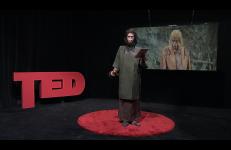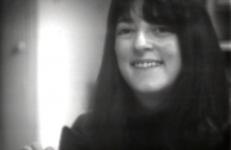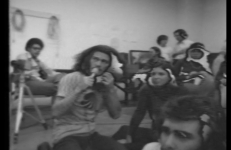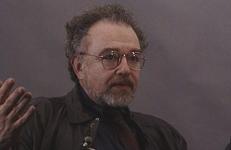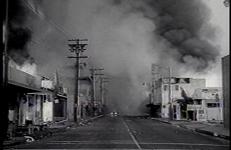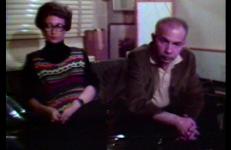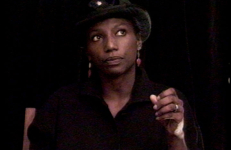“[A] rather perverse exercise in futility,” this tape documents Baldessari’s response to Joseph Beuys’s influential performance, How to Explain Pictures to a Dead Hare. Baldessari’s approach here is characteristically subtle and ironic, involving ordinary objects and a seemingly banal task. The philosophical underpinnings of Baldessari’s exercise are structuralist theories about the opaque and artificial nature of language as a system of signs.
Art Criticism
"Fusco revives and embodies the chimpanzee animal psychologist Dr. Zira from the original Planet of the Apes films of the late 1960s and early 1970s. In her Skyped-in introduction, esteemed feminist theorist and technoscience philosopher Donna Haraway explains that Dr. Zira narrowly escaped death in the third film and has been living in hiding, observing human behavior through visual culture. In her lecture, Dr.
In April 1974, Video Data Bank co-founders Lyn Blumenthal and Kate Horsfield conducted their first interview, an in-depth conversation with art historian and curator Marcia Tucker. During the remainder of that year, Blumenthal and Horsfield went on to interview four more notable art world women: Joan Mitchell, Lucy Lippard, Agnes Martin and Ree Morton.
The video content—a live-feed image processing tape—shows intellectual discussion among SAIC Video Area students and faculty members. Instead of being a prescriptive monologue from school to students, Phil sits among the crowd and moderates the session. The decentralized and non-hierarchical academic setting—students and faculty sitting on the floor and cushions in a circle—is typical of the ’70s. At times, students burst into laughter, dancing, and lounging on the floor, hence creating a laid-back environment.
Allan Trachtenberg is one of the most esteemed figures in contemporary photographic history and cultural studies. He received an Andrew W. Mellon Foundation Emeritus Fellowship for his continuing work on Wright Morris. Other honors include fellowships from the American Council of Learned Societies, the National Endowment for the Humanities, the Rockefeller Foundation and the Guggenheim Foundation. Trachtenberg is the Neil Gray, Jr. Professor Emeritus of English and American studies at Yale University, where he taught for thirty-five years.
Marcia Tucker (1940 - 2006) was a curator, writer and art historian, known for founding the New Museum of Contemporary Art after her dismissal from her curatorial post at the Whitney Museum of American Art due to creative disagreements. Tucker served as the visionary director of the New Museum from 1977 to 1999, during which time she organized major exhibitions like The Time of Our Lives (1999), A Labor of Love (1996), and Bad Girls (1994), and edited the series Documentary Sources in Contemporary Art. As a curator,Tucker championed social engagement, exploration and artistic process. She considered the museum a “laboratory” organization where both art and the practices of the institution itself were always in question. After leaving the New Museum, and until her death in 2006, Tucker worked as a freelance art critic, writer, and lecturer.
This work was produced in connection with Icono Negro, a three-artist show at Long Beach Museum of Art exploring the dynamics and distinctions of black video art. Three works featured in the show—Tony Cokes’s Black Celebration, Philip Mallory Jones’s What Goes Around, and Lawrence Andrews’s An I for an I—are shown in their entireties and commented upon by curator Claire Aguilar and video artists Ulysses Jenkins and O. Funmilayo Makarah.
Part of the Long Beach Museum of Art’s Collectors of the Seventies series, this tape enters the home and art collection of Dorothy and Herbert Vogel. The Vogels live in a nondescript high-rise in the Yorkville section of New York City’s East Side. Their three and a half rooms serve as their museum for Larry Poons, Robert Morris, Philip Pearlstein, Robert Mangold, Sylvia Mangold, Dennis Oppenheim, Richard Nonas, John Tuttle, Sol Lewitt, Dan Graham, Richard Nonas, John Chamberlain, Christo, Donald Judd, Carl Andre, and Robert Ryman.
Interview by Douglas Davis.
Michele Wallace's attention to the invisibility and/or fetishization of black women in the gallery and museum worlds has made possible new critical thinking around the intersection of race and gender in African American visual and popular culture, particularly in what she has called "the gap around the psychoanalytic" in contemporary African-American critical discourse.
It was 1990 and, although the iron curtain was falling, Soviet official control was still iron-fisted. Camcorder reporter Skip Blumberg went along with a group of art aficionados on a tour of the Moscow studios of the unofficial artists, an underground community of talented, courageous and often wacky conceptual artists. His report reveals an insider’s view of the art world and, at the same time, is a video about making a video.
Swamp Swamp and Wurmburth are each comprised of a series of tightly cropped shots of small, hand-made table-top sculptures or "sets". Paint and many other materials that behave like paint (i.e. lotion, shampoo, foodstuffs) are blown through these environments with plastic tubing and forced air. Each edited collection of shots makes an endless cycle of primal sludge and rupturing goo.
1970 marked the publication of Gene Youngblood’s now-formative Expanded Cinema – a text that was instrumental in legitimizing video and new media as viable and serious artistic forms. Youngblood went on to a career in both practice and theory, making a life’s work of championing the uses of video towards both social and political ends. This interview, conducted at SAIC, comes seven years after the release of Expanded Cinema and details its author’s primarily philosophic concerns with the medium of video.





